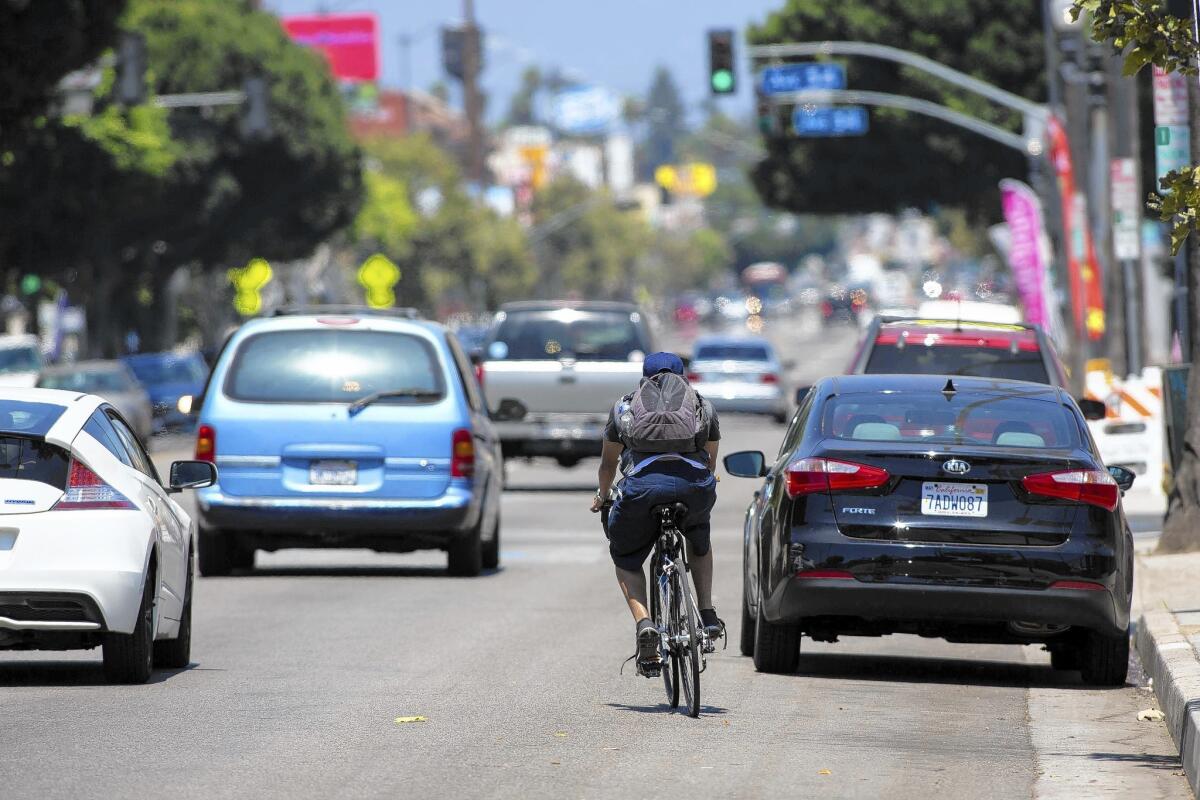Halted Figueroa bike lane project riles cycling activists

- Share via
More than 200 miles of Los Angeles streets have been remade in the last five years, with city officials adding bike lanes where the car alone had long been king.
In many cases, making room for cyclists has meant reducing the space for motorists, causing grumblings in some neighborhoods but doing little to slow the bike lane march.
Until now. Over the last 18 months, political opposition has stalled bike lane projects on Lankershim Boulevard in the San Fernando Valley and Westwood Boulevard on the Westside. Downtown commuters have begun to loudly complain about bike lanes in the 2nd Street tunnel, where two out of four car lanes have disappeared.
But the bike lane boom has really met its match in an unlikely place — northeast L.A. It was here transportation planners had hoped just three years ago to complete a looping system of lanes connecting Highland Park with Eagle Rock and other nearby neighborhoods.
Last week, City Councilman Gil Cedillo announced he is halting work indefinitely on northbound and southbound bike lanes planned for a three-mile stretch of North Figueroa Street, despite an aggressive two-year campaign by cycling advocates.
Cedillo said he feared the loss of a single southbound car lane would slow emergency response times of police officers and firefighters on Figueroa, which runs roughly parallel to the 110 Freeway. He dismissed cyclists as a tiny but vocal segment of the population. And in a letter to activists, he said he would rather focus efforts on improving crosswalks and traffic signals.
Figueroa, like Lankershim and Westwood boulevards, are part of the city’s Bicycle Plan, a document that mapped out 719 miles of planned bike lanes. Recent moves by L.A. lawmakers show there is “a great reluctance to follow through on the city’s commitment” to that plan, said Eric Bruins, planning and policy director for the Los Angeles County Bicycle Coalition.
“We’re greatly concerned that, at this point, the city has lost a great deal of momentum,” the bike lane advocate said. “Residents of the city still very much want these improvements and want to bicycle, but they’re looking to the council to make the streets safe to ride on.”
Cedillo contends the bike plan, approved by the council in 2011, was developed by 1,000 people in a city of around 4 million. “That’s a very microscopic percentage of people to set an agenda,” he said.
On Figueroa, a Times review of accident data between 2002 and 2012 found 68 car-versus-bicycle collisions between Avenue 26 and York Boulevard — three of them resulting in severe injuries. The data show 153 events took place between cars and pedestrians during the same period, including nine that resulted in death.
City transportation officials say they haven’t looked at how those numbers compare to other L.A. streets. But the Times review shows Figueroa has a greater number of accidents than other major corridors in the northeast area.
Bicycle advocates have long argued that the addition of dedicated lanes can achieve multiple goals: spurring more people to take up cycling — and reducing the number of cars on the road — while calming traffic in a way that cuts down on accidents and keeps drivers within the speed limit.
Opponents argue that too few bicyclists are on the road to justify the loss of so many car lanes and the suffering that comes with lengthier commutes.
The debate has been especially intense in northeast L.A. Activists say Cedillo, who was videotaped voicing support for Figueroa bike lanes during his 2013 election campaign, broke a promise to constituents. One accused the councilman on Twitter of supporting “fast cars and dead kids.”
Leading the charge for the bike lanes is Josef Bray-Ali, owner of the Flying Pigeon bike shop on Figueroa and a resident of Cedillo’s District 1. Bray-Ali agreed last year to let Cedillo use his store as the backdrop for campaign photographs. Now he is waging a campaign against the councilman, firing off emails, blog posts and highly critical messages on Twitter as he pushes for the Figueroa project to be resurrected.
“We’re going to have to get in his face nonstop, constantly,” Bray-Ali said. “Because I don’t want to live in a neighborhood with unsafe streets anymore. I’m not cool with the status quo, and I’m not going to back down.”
On the opposite end of the spectrum is Tom Topping, publisher of the Boulevard Sentinel, a monthly newspaper that writes about northeast L.A. and has been highly critical of bike lanes. Topping’s newspaper cheered Cedillo for putting a stop to the Figueroa plan, which would have cut the number of car lanes from four to three, saying he had refused to capitulate to bicycle “extremists.”
“Cedillo represented the voters who elected him,” Topping said in an email.
The Figueroa project originally had the support of Councilman Ed Reyes, whose term ended in June 2013, before he was able to carry out the initiative. Reyes viewed the lanes as a way of making Figueroa more pedestrian friendly and boosting business activity. All three candidates to succeed him — including Cedillo — signaled their support for bike lanes on the corridor.
Reyes backed Cedillo’s opponent in last year’s bitter council contest. After the election, the project’s fortunes changed. Cedillo called for new community meetings on the Figueroa proposal.
To drum up attendance, Cedillo set up phone banks and left pre-recorded “robo calls” for his constituents, tactics typically used in political campaigns. Cedillo said the outreach was needed because bicycle activists had brought in “ringers” — people who lived outside his district.
“We didn’t try to bolster our meeting with people who had an agenda. We spoke to the immediate community,” he said. “There’s 98.5% of the population that hasn’t been in the conversation.”
The sessions drew dozens of cyclists. But they also attracted bike lane foes, who scoffed at the idea that the Figueroa project would improve the neighborhood. “Traffic is not going to get any better,” said Highland Park resident Carl Amato. “If you put a thousand more bikes on the street, it’s not going to get any better.”
With bike lanes, transportation officials estimated that only two intersections on Figueroa would experience major delays, adding 47 seconds to southbound morning commutes. Cedillo said he is relying in part on input from an LAPD captain who said bike lanes slow emergency response times.
At the most recent neighborhood meeting, city officials distributed ballots to gauge support for a “road diet” on Figueroa to accommodate the bike lanes.
The results collected by Cedillo showed an audience evenly divided, with 44 in favor and 44 against, according to Cedillo aide Jennifer Rivera.
Those who didn’t say where they live were also split, with 17 in favor and 17 against. Those who confirmed they live outside Cedillo’s district favored the bike lanes by a vote of 18 to 14.
Last week, bike lane protesters showed up at Cedillo’s district office in Highland Park wearing Day of the Dead skeletal garb, looking to highlight dangers bicyclists face.
Two days later, Cedillo sent a letter to activists saying work on the bike lanes had been halted indefinitely.
The move disappointed community activist Monica Alcaraz, who hoped the lanes would tame Figueroa traffic.
“People drive like it’s a freeway,” she said.
Follow @DavidZahniser for more news about Los Angeles city government.
More to Read
Sign up for Essential California
The most important California stories and recommendations in your inbox every morning.
You may occasionally receive promotional content from the Los Angeles Times.














